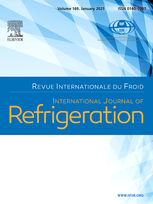
Document IIF
Recherche expérimentale sur les caractéristiques de chauffage d’un système de pompe à chaleur aérothermique comprenant un plancher chauffant avec rayonnement direct par tubes.
Experimental research of heating characteristics on an air source heat pump system with capillary direct floor radiant.
Résumé
A new-type air source heat pump system with capillary direct floor radiant (ASHPCFR) was proposed, in which the vapor refrigerant condensed directly in the capillary under the floor to heat the room. Theoretical calculation of heat transfer in the capillary floor was conducted. The results indicated that the optimal capillary spacing should be 100 mm and it was best for a thickness smaller than 60 mm with the floor cement layer. An experimental apparatus for the ASHPCFR system was developed, and its low-temperature heating process and normal heating process were experimentally investigated. Experimental results showed that when the outdoor temperature was -5 °C, the indoor air temperature reached 20 °C after 120 min of running, while the temperature difference of a 20 mm thick cement floor could reach 1.73 °C and its maximum temperature could reach 27.5 °C. When the outdoor temperature was -10 °C, the system heating COP was stable at 3.06.
Documents disponibles
Format PDF
Pages : 224-235
Disponible
Prix public
20 €
Prix membre*
Gratuit
* meilleur tarif applicable selon le type d'adhésion (voir le détail des avantages des adhésions individuelles et collectives)
Détails
- Titre original : Experimental research of heating characteristics on an air source heat pump system with capillary direct floor radiant.
- Identifiant de la fiche : 30033377
- Langues : Anglais
- Source : International Journal of Refrigeration - Revue Internationale du Froid - vol. 170
- Date d'édition : 02/2025
- DOI : http://dx.doi.org/10.1016/j.ijrefrig.2024.11.031
Liens
Voir d'autres articles du même numéro (37)
Voir la source
Indexation
- Thèmes : Techniques des pompes à chaleur
- Mots-clés : Pompe à chaleur; Système aérothermique; Transfert de chaleur; Plancher; Chauffage; Experimentation
-
Investigation of air-source heat pump using hea...
- Auteurs : XU S., DING R., NIU J., et al.
- Date : 06/2018
- Langues : Anglais
- Source : International Journal of Refrigeration - Revue Internationale du Froid - vol. 90
- Formats : PDF
Voir la fiche
-
Experimental Performance Study of Solar-Assiste...
- Auteurs : LI Z., DU Y., PAN Y., ZHANG F., MENG Z., ZHANG Y.
- Date : 10/2022
- Langues : Anglais
- Source : Energies - vol. 15 - n. 20
- Formats : PDF
Voir la fiche
-
Aerotermia como energía para la sustitución de ...
- Auteurs : DÍAZ D.
- Date : 09/2016
- Langues : Espagnol
- Source : Frío Calor Aire acondicionado - vol. 44 - n. 494
- Formats : PDF
Voir la fiche
-
Experimental analysis of parallel operation of ...
- Auteurs : REUM T., SCHMITT D., SUMM T., TRINKL C., OCHS F., SCHRAG T.
- Date : 03/2025
- Langues : Anglais
- Source : International Journal of Refrigeration - Revue Internationale du Froid - vol. 171
- Formats : PDF
Voir la fiche
-
A novel characteristic index for frosting suppr...
- Auteurs : LIANG S., WANG W., SUN Y., et al.
- Date : 01/2020
- Langues : Anglais
- Source : International Journal of Refrigeration - Revue Internationale du Froid - vol. 109
- Formats : PDF
Voir la fiche
